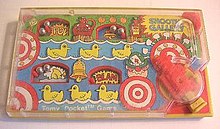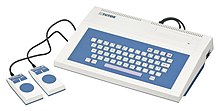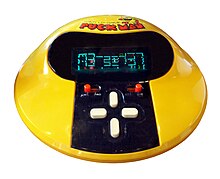Tomy
This article needs additional citations for verification. (April 2023) |
It has been suggested that portions about the pre-merger history of Tomy be split out into another article titled Tomy (1924–2006). (Discuss) (April 2023) |
| |
Native name | 株式会社タカラトミー |
Romanized name | Kabushikigaisha takara tomī |
| Company type | Public |
| TYO: 7867 | |
| Industry |
|
| Predecessor |
|
| Founded | March 1, 2006 (original Tomy, 1924; former Takara, 1955) |
| Headquarters | 7-9-10, Tateishi, |
| Products | Details |
| Revenue | |
| Total assets | |
| Total equity | |
| Owner | Tomiyama family through Tsukasa Fudōsan KK (7.94%) |
Number of employees | 509 (as of March 31, 2019)[3] |
| Divisions |
|
| Subsidiaries |
|
| Website | takaratomy.co.jp |
Tomy Company, Ltd.
History and corporate name
Before the merger
The company was named Tomy as an abridgement of Tomiyama, which was the founder's surname. Starting as a manufacturer, Tomy had the largest product development team in the toy industry and plaudits for its technology. Nonetheless, by its third generation, president Mikitaro Tomiyama decided to streamline the company to be more competitive with wholesaler
Tomiyama was shocked when his son told him that Tomy's toys were bad and that he wanted to work for Bandai when he grew up. In response, he created the moderately successful
Tomy learned about the growing popularity of Pokémon through monthly CoroCoro Comic and obtained the commercial rights. Bandai at the time was busy with its big hit, Tamagotchi, and was not interested in Pokémon. Tomy acquired the rights to commercialize a wide range of merchandise, mainly toys, and released the "Monster Collection" of figures next year. The anime became a huge hit, and sales of related products doubled. Tomy (who had been the third largest company in the toy industry since the 1980s) rose to second place in 1997.[citation needed]
In 2001, competitor Takara's hit franchise, Beyblade, and Pokémon's slump saw Takara regaining second place and Tomy falling again to third. However, Beyblade subsequently faltered (which adversely affected Takara's fortunes; Tomy merged with the suffering company and became Takara–Tomy).[citation needed]
After the merger

The company decided to use the name "Tomy" in international subsidiaries, and "Takara-Tomy" in Japan, because Tomy had built considerable international brand recognition while Takara's products (
In Western media, the Takara–Tomy merger was typically characterised as a 'takeover' of Takara by Tomy (likely because several years of losses had put Takara in a financially weakened state at the time of the merger (although Takara did have significantly higher sales than Tomy)). However, the companies' management teams had previously discussed merging (including at times when Takara appeared stronger). Under Japanese corporate law, the move was a merger of both companies on an equal basis.
Post-merger media speculation about the control of brands from the Takara–Tomy merger arose from the new use of a "TOMY" copyright on all packaging (including former Takara brands shipped by Hasbro) (but this was merely a consequence of the decision to use only the Tomy name in international subsidiaries). In Japan, Takara-Tomy continues to use both Tomy and Takara as distinct brand names on toy ranges which originated in each separate company, and most new toy ranges or stand-alone products now carry the new Takara–Tomy brand.
]Products


Takara-Tomy has manufactured a broad range of products based on its own properties which include, from the Tomy side:
Tomy sells many products worldwide, including baby and pre-school toys,
A list of notable products include:


- Armatron
- Atollo – construction toy
- Bakugan: Battle Planet
- B-Daman – marble shooting toys
- Beyblade – top fighting game
- Blip (game) – mechanical Pong-type handheld game
- Blythe
- Boggle Flash
- Choro-Q – micro toy cars
- Chuggington
- Compass
- Crossbows and Catapults
- Duel Masters trading card game franchise
- Eldran series
- Flip Flap – solar-powered plant
- Furby
- Gashapon – vending machines
- Guitar Rockstar
- i-SOBOT[7]
- Jenga
- Jenny
- KatekyoHitman Reborn! Flame Rumble – a series of fighting games based on the manga/anime for the Nintendo DS
- Kamiwaza Wanda
- Kingdom Hearts Trading Card Game
- Lamaze
- Licca
- Omnibot – line of toy robots
- train setsystem (called "Tomica World" outside Japan)
- Pop-up Pirate
- Pretty Rhythm
- PriPara - the successor to the Pretty Rhythm series
- Q-steer – micro radio-controlled cars based on Choro-Q
- Rummikub
- Screwball Scramble
- Shinkansen Henkei Robo Shinkalion
- Starriors
- Switch 16
- Thomas and Friends– Plarail, Capsule Plarail, Tomica, and Tomix themes, and preschool products
- Thunderbirds
- Tomica – die-cast toy
- Tomica Hyper Rescue Drive Head Kidō Kyūkyū Keisatsu
- Tomica Kizuna Gattai Earth Granner
- Tomix– the model railway brand of Tomytec, a subsidiary of Takara Tomy
- Tomy Tutor – home computer
- Tomytronic– 3D handheld game series
- Transformers
- Tron – action figures and vehicles based on the Disney film
- Teletubbies
- Wedding Peach
- Mermaid Melody Pichi Pichi Pitch
- My Hero Academia
- Cardcaptor Sakura
- Cardcaptor Sakura: Clear Card
- Slayers
- Revolutionary Girl Utena
- Z-Knights – line of constructible models of humanoid robots styled after knightsthat ran from 1991 to 1993.
- Zoids
- Zootopia
- Water Games[8]
References
- ^ a b "Company profile".
- ^ a b c d e "Consolidated financial statement for end of the fiscal year ending March 31, 2014" (PDF). Tomy Co., Ltd. 12 December 2014.
- ^ "Corporate Profile|Corporate Information|TOMY Company, Ltd". Takaratomy.co.jp. Retrieved 22 August 2015.
- ^ "Corporate History|Corporate Information|TOMY Company, Ltd". www.takaratomy.co.jp. Retrieved 14 March 2016.
- ^ "Tomy Uk". Tomy.co.uk. Retrieved 22 August 2015.
- ^ Masters, James. "TOMY Pocket Games - The USA List". Masters.me.uk. Retrieved 22 August 2015.
- ^ "I-Sobot". Isobotrobot.com. Retrieved 22 August 2015.
- ^ Coopee, Todd (16 May 2016). "Water Games from TOMY (1976)". ToyTales.ca.
External links
- Official website
 (in English)
(in English) - Tomy International
